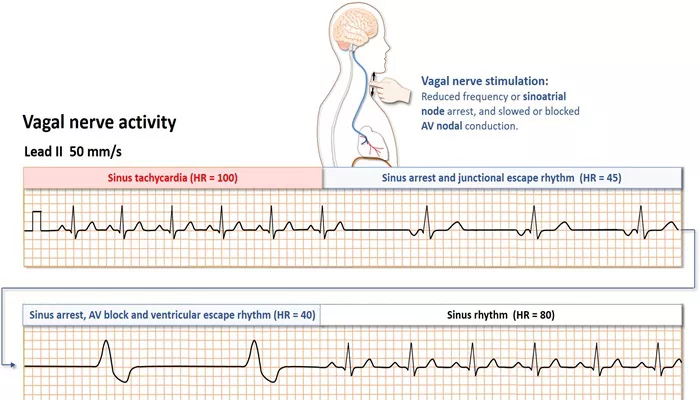Respiratory sinus arrhythmia (RSA) is a naturally occurring variation in heart rate that occurs during a breathing cycle. It reflects the heart’s ability to adapt to the demands of respiration, indicating autonomic nervous system function, particularly the parasympathetic (vagal) influence on the heart. RSA is considered a measure of cardiac vagal tone and is an important physiological phenomenon in both clinical and research settings. Understanding how to measure RSA accurately can provide valuable insights into cardiac health and autonomic function.
The Importance of Measuring RSA
RSA is not just a curious physiological quirk; it has significant implications for understanding heart health. A pronounced RSA is typically a sign of a healthy, well-functioning autonomic nervous system. Conversely, a reduced or absent RSA can indicate various pathologies, including cardiovascular diseases, diabetes, and stress-related disorders. Measuring RSA can help in:
Assessing Autonomic Function: RSA is a non-invasive marker of parasympathetic activity. It can be used to evaluate autonomic dysfunction in various diseases.
Monitoring Cardiac Health: RSA can provide insights into heart health and is often used in stress tests and heart rate variability (HRV) analyses.
Research: RSA is used in numerous studies to understand the autonomic nervous system’s role in health and disease.
Methods to Measure Respiratory Sinus Arrhythmia
Several methods can be employed to measure RSA, each with its advantages and limitations. These methods typically involve recording heart rate and respiration simultaneously to analyze the heart rate variability in relation to the breathing cycle.
see also: What Is Ectopic Arrhythmia?
1. Electrocardiography (ECG)
Procedure:
Setup: Attach ECG electrodes to the patient’s chest to record heart electrical activity. Standard 12-lead ECG or a simpler 3-lead setup can be used depending on the context.
Recording: Record ECG signals while the patient breathes normally.
Ensure a calm and controlled environment to minimize artifacts.
Respiration Monitoring: Simultaneously record respiration using a respiratory belt or spirometer.
Data Analysis: Analyze the R-R intervals (the time between successive R-waves) to detect variations corresponding to the respiratory cycle.
Software tools can be used to plot the R-R interval against the respiratory cycle to visualize RSA.
Advantages:
High precision and reliability.
Detailed information on heart rhythm and conduction.
Limitations:
Requires specialized equipment and trained personnel.
Potential discomfort for the patient due to electrode placement.
2. Photoplethysmography (PPG)
Procedure:
Setup: Place a PPG sensor, typically on a finger or earlobe. The sensor uses light to detect blood volume changes in the microvascular bed of tissue.
Recording: Collect PPG signals along with respiratory signals, which can be recorded using a respiratory belt or nasal cannula.
Data Analysis: Analyze the PPG waveform to determine the time intervals between successive peaks (analogous to R-R intervals in ECG) and correlate with the respiratory cycle.
Advantages:
Non-invasive and more comfortable for the patient.
Easier to set up compared to ECG.
Limitations:
Less precise than ECG.
Susceptible to motion artifacts and ambient light interference.
3. Heart Rate Variability (HRV) Analysis
Procedure:
Setup: Record heart rate data using either ECG or PPG.
Respiration Monitoring: Simultaneously record respiratory data.
Data Analysis: Use HRV analysis software to compute RSA. Time-domain and frequency-domain analyses can be used to quantify RSA.
Time-Domain Analysis:
Compute the standard deviation of the R-R intervals (SDNN) and the root mean square of successive differences (RMSSD).
RSA can be inferred from the cyclical patterns in these time-domain measures.
Frequency-Domain Analysis:
Use spectral analysis to decompose the heart rate signal into its frequency components.
RSA typically appears in the high-frequency (HF) band (0.15–0.4 Hz), which corresponds to the respiratory frequency.
Advantages:
Provides a comprehensive analysis of heart rate dynamics.
Can be used with various heart rate recording methods.
Limitations:
Requires sophisticated software and expertise in signal processing.
Practical Considerations
Patient Preparation:
Ensure the patient is relaxed and in a comfortable environment.
Avoid caffeine, alcohol, and nicotine before the measurement, as these can affect heart rate and RSA.
Interpretation:
Consider individual variability in RSA due to factors like age, fitness level, and baseline autonomic tone.
Compare RSA measurements to normative data to assess autonomic function.
Applications of RSA Measurement
Clinical Practice:
Diagnosis: RSA measurement can aid in diagnosing autonomic dysfunction in conditions like diabetic neuropathy, heart failure, and anxiety disorders.
Monitoring: Track changes in autonomic function over time or in response to treatments.
Research:
Physiological Studies: Investigate the role of the autonomic nervous system in health and disease.
Intervention Studies: Evaluate the impact of interventions (e.g., exercise, meditation) on autonomic function.
Conclusion
Measuring respiratory sinus arrhythmia is a valuable tool in both clinical and research settings, providing insights into autonomic nervous system function and cardiac health. Various methods, including ECG, PPG, and HRV analysis, can be employed to measure RSA, each with its specific advantages and limitations. Accurate measurement and interpretation of RSA can help diagnose and monitor various conditions, contributing to a better understanding of heart health and autonomic function.

